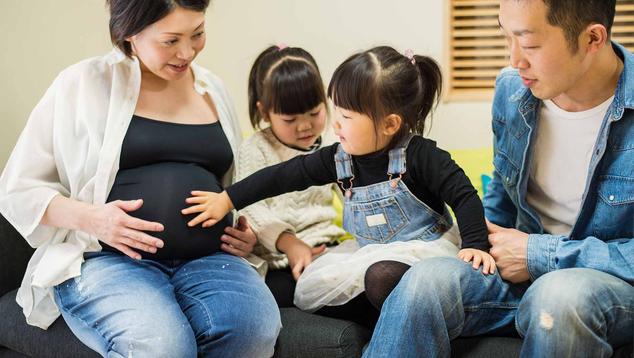Story Highlights
- 47% think one or two children is ideal, including 44% who say two
- 45% of U.S. adults say three or more children is ideal family size
- Black adults, more religious, younger adults favor larger families
WASHINGTON, D.C. -- Americans are about evenly divided in their views of whether smaller versus larger families are preferable. When asked about the ideal number of children for a family to have, a 44% plurality of U.S. adults think having two children is best, and 3% say a single child is ideal, totaling a 47% preference for smaller families.
At the same time, 45% of Americans favor larger families, including 29% who say having three children is ideal, 12% who think four is best, and 2% each who prefer having five or six or more children.
Just 2% think the ideal family does not include any children at all.
These findings, from aggregated Gallup polls in June and July 2023, translate to an average of 2.7 children considered ideal.
Americans’ Preference for Smaller Families Had Been Recent Norm
Gallup began periodically measuring Americans’ preferred family size in 1936 and found 64% favoring at least three children at that time. Support for larger families of three or more children peaked at 77% in 1945, at the end of World War II and just before the baby boom -- yet a minimum of 61% of U.S. adults favored families of at least three children through 1967. At the highest point during the baby boom, the average number of children per U.S. family was 3.6.
Between 1967 and 1971, preferences for larger families plummeted from 70% to 52%. This drop was likely fueled at least in part by concerns about a global population explosion, resulting from the 1968 bestselling book entitled The Population Bomb. Additionally, changes in societal norms -- such as women’s increased role in the workplace, a growing acceptance of premarital sex and economic concerns -- could have affected views.
In 1973, Americans’ preference for smaller families of one or two children became the standard, often significantly outpacing a desire for larger families of three or more children in the years that followed. These preferences were evident in U.S. birth rates, as the average number of children per family in the U.S. dropped to 1.8 by 1980 -- half of what it was at the peak of the baby boom.
After climbing to 64% in 1986, Americans’ preference for smaller families trended downward, but with more notable spikes in times of economic turmoil, including 57% in 2011 after the Great Recession. Conversely, amid stronger economic times, such as in 1997 and 2018, the gap between preferences for smaller and larger families narrowed.
Americans’ belief that the ideal family size includes three or more children has been rising steadily in recent years, currently up four percentage points from the previous reading in 2018 to its highest point since 1971. The latest measure is one of the few instances when preferences for smaller families (of one or two children) and larger families (of three or more children) are statistically tied in Gallup’s trend.
Gallup did not ask this question during the COVID-19 pandemic, a period of great tumult both economically and socially in the U.S., but government data showed a decrease in the U.S. birth rate as a result of the pandemic.
Americans Still Favor Parenthood
Regardless of the number of children they consider to be ideal, nine in 10 U.S. adults have children or would like to. This includes 69% who already have children, 15% who are aged 18 to 40 and are not yet parents but say they want to be someday, and 6% who are aged 41 and older and do not have children but wish they did. Just 8% of U.S. adults indicate no intent or longing to have children.
Each of the current readings is within three percentage points of the average of the four polls conducted between 1990 and 2018.
As would be expected, there are significant differences between young adults (those under 30) and older age groups. Young adults are far less likely than their older counterparts to already have children. They are also at least twice as likely as middle-aged and older adults to say they do not want to. However, the vast majority of those under age 30 either already have children (21%) or hope to someday (63%).
Americans’ Actual Family Size Doesn’t Always Match Their Ideal
U.S. adults’ views of the best family size have not always tracked with birth rates in the U.S., particularly in recent years. Since the Great Recession, Americans have been increasingly likely to say larger families are preferable, but birth rates in the U.S. have been declining. This suggests that while they may see larger families as ideal, other factors are preventing them from implementing this in their own lives.
In all, 31% of U.S. adults report that they have not had any children, while 14% have had one child, 28% have had two, 15% have had three, 7% have had four and 5% have had five or more.
A 48% plurality of those without children and a slim 51% majority of parents of one each see having two children as ideal.
The ideal for parents of two and three children generally conforms with what they have, as 54% of parents of two and a 46% plurality of parents of three say their own family situation is best. Those with four or more children are most inclined to favor larger families (43% say four or more children is ideal), yet slightly more of these parents, 49%, say between one and three children is ideal.
Views of Ideal Family Size Differ Among Subgroups
Men and women do not differ much in their views of the ideal family size, with each about evenly divided between favoring smaller and larger families. However, there are sizable differences among a number of other demographic subgroups, including by age, race/ethnicity, annual household income, religious preference and service attendance, and party identification.
As has been the case in the recent past, younger adults -- those aged 18 to 29 -- are more likely than any other age group to say having three or more children is ideal. Likewise, Black and Hispanic adults favor larger families more than White adults do. Republicans and Republican-leaning independents and those with lower incomes are more likely than their counterparts to view larger families as ideal.
Those who say they do not identify with a religion believe smaller families are ideal, while Catholics and those who frequently attend religious services favor larger families.
A statistical analysis that accounts for the effect of demographic and attitudinal variables finds the strongest predictors of ideal family size are race/ethnicity and church attendance. In addition, age, income, religious affiliation or lack thereof and political identification are also meaningful predictors. Educational attainment is unrelated to the preferred number of children once the effects of other variables are taken into account.
Bottom Line
Americans’ preference for smaller families, which has been the norm for the past 50 years, is shifting as their view of the ideal number of children in a family has crept up to the highest level since 1973. Still, the U.S. birth rate remains low compared with the 1970s, suggesting that Americans’ views of the ideal may not be their personal reality.
While most adults under 30 have not had children, the total percentage of young adults who have had children or want to someday is equal to or nearly as high as adults in older age groups who say the same. Young adults are also more likely than older age groups to think having three or more children is ideal. Thus, the greater risk of the U.S. population shrinking due to a declining birth rate may stem from young adults waiting much longer than prior generations to start having children rather than from a decreased desire to have children altogether.
To stay up to date with the latest Gallup News insights and updates, follow us on Twitter.
Learn more about how the Gallup Poll Social Series works.
View complete question responses and trends (PDF download).




